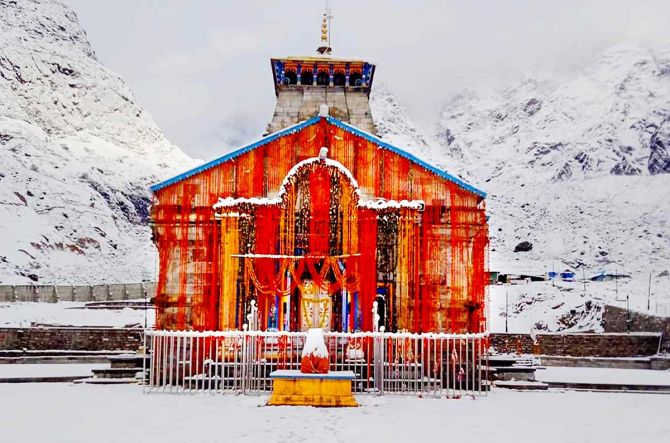'This is probably why the late General Bipin Rawat, who hails from the Garhwal Himalaya, said that the existing roads are fine with the army.'

Dr C P Rajendran is one of India's foremost experts in the study of seismo-tectonics as also the study of earthquake and tsunami geology having closely studied earthquakes across the sub-continent including the major earthquakes of Latur, Rann of Kutch and also in the central Himalayas.
An expert in the field of paleoseismology, Dr Rajendran, who is at the Indian Institute of Science in Bengaluru, is deeply disappointed with the Supreme Court judgment on the Char Dham road project.
"The Char Dham road project is a fundamental violation of all environmental norms and conservation strategies that need to be followed in the Himalayan mountain terrains for any constructional activities," Dr Rajendran tells Rediff.com Senior Contributor Rashme Sehgal.
The first of a two-part interview:

You have been an outspoken critic of the Char Dham road project which you have described as a freeway to disaster for the Himalayas.
Despite your criticism based on solid scientific analysis as also that of several other scientists, the Supreme Court has given the green signal for its construction.
What signal does this send out?
I feel terribly disappointed with the green signal for the Char Dham road project, issued by the honourable Supreme Court.
It is ironic that this 'autobahn' project in a fragile mountainous area was initiated after the Uttaranchal floods of 2013 when the prime minister laid the foundation for the Char Dham Pariyojana in December 2016, dedicating it to the flood victims.
This current project ignores the fact that over-construction in the hills had exacerbated the 2013 tragedy.
In my opinion, the Court should have looked into the scientific objections more carefully and conducted a technically sound environmental impact assessment using the services of the independent experts.

The Supreme Court insists this is a strategic feeder road leading up to the India-China border and therefore extending it to a 10 metre width was necessary. This, the judges believe, will meet the infrastructural requirements of the defence forces. How do you perceive this statement?
The Court went back on its earlier judgment of September 2020 favouring a narrow width for the road, based on the recommendation of a high-powered scientific committee appointed in 2019, limiting carriageway to 5.5 metres.
Now the Court believes that widening the road is important for the Indian Army.
The Garhwal-Kumaun Himalaya is the most fragile part of the Himalaya and inherently most vulnerable to landslides because of the geological characteristics.
For example, on the Chinese side, the Himalayas are [made of harder] rock but on the Indian side, it is largely shale, which is a weak sedimentary rock.
The widening of the road to 10 metres involves further destabilising the slopes leading to increased incidences of landslides.
This situation will further complicate the army movement and work against the efficiency to combat the enemies.
Massive effort would be required on clearing or reconstructing the damaged road that could happen at a most critical time.
This is probably the reason why the late General Bipin Rawat, who hails from the Garhwal Himalaya, said that the existing roads are fine with the army as it has the capability of air-lifting its troops and heavy artillery.
Considering the difficult part of the Himalaya on our side, as commented by experts like Manoj Joshi, India could overcome this disadvantage by having more forward deployments than the Chinese who are able to move quickly forward because of the flatter Himalaya terrain on their side.

We all know that defence requirements are paramount, but this Char Dham project is being constructed in violation of basic environmental norms that are a must given the composition of the Himalayan terrain.
How can this be overlooked especially since the construction of this road has already resulted in one landslide every day during the rainy season as documented by NGOs working in this region.
The future will testify that this is going to be an unmitigated disaster, which will make the life of the local people even more miserable. The facts are all there to see.
The process of construction requires tens of thousands of fully grown trees being cut, cutting into mountain sides, blasting, and immense quantities of debris being dumped into rivers.
There have been so many destructive landslides, floods and avalanches, resulting in the destruction of power stations and dams being knocked out.
After the four-lane highway is completed, it will lead to a tenfold increase in the flow of tourists and pilgrims.
The increased number of temporary visitors will place its own demands for construction of hotels, guest houses, other construction, increased requirements for water, waste disposal, and sanitation.
Feature Presentation: Ashish Narsale/Rediff.com











 © 2025
© 2025